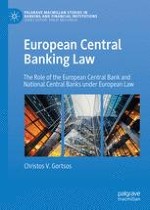2020 | OriginalPaper | Chapter
7. The Basic Tasks of the European Central Bank Within the Eurosystem and Issuance of Banknotes and Coins
Author : Christos V. Gortsos
Published in: European Central Banking Law
Publisher: Springer International Publishing
Activate our intelligent search to find suitable subject content or patents.
Select sections of text to find matching patents with Artificial Intelligence. powered by
Select sections of text to find additional relevant content using AI-assisted search. powered by
